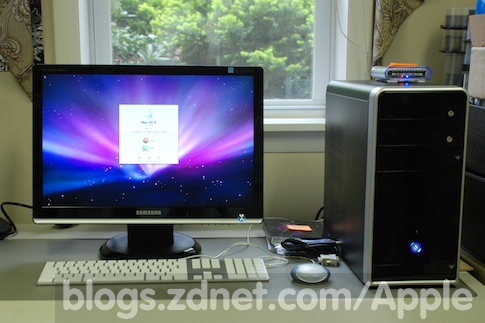Psystar: Just how loud is it? (updated 2x)


I don't have a wireless card in it yet and my desk is too far away from my router to string an Ethernet cable, so I'm offline for the time being and cannot test things like Software Update. I ordered a D-Link DWA-556 draft-n WiFi card which should be here on Saturday.
I noted previously (in a comment) that the motherboard is a Gigabyte S-Series, Model GA-G31M-S3L featuring:
- Supports Intel Core 2 multi-core and 45nm processors
- Solid capacitors design in CPU VRM
- Dual Channel DDR2 800 for outstanding system performance
- Integrated Intel Graphics Media Accelerator 3100 (Intel GMA 3100)
- Integrated SATA 3Gb/s interface
- Features high speed Gigabit Ethernet
- Integrated High Definition audio
The case is an ASUS TM-210 mini tower, (US$55 from NewEgg) featuring:
- Power on/off button with blue LED light
- All door-covered drive bays
- Excellent thermal solution supporting the latest processing platform
- Two 5.25" external, two 3.5" external, and three 3.5" internal drive bays
I connected an external FireWire hard drive (an OWC Mercury On-The-Go 500GB) to the Psystar and copied an OS X user account from it using Apple's Migration Assistant. I also booted directly from the external FW drive without issue.
The Samsung 206BW 20” LCD monitor (US$299 from Tekserve) is almost a perfect complement to the Psystar's black case. The Sammy glossy black bezel and hint of aluminum looks like it was designed for the Psystar black case.
I successfully installed iLife and iWork '08 and both went fine. However I noticed that the optical drive is pretty loud when accessing the disc. When just the machine itself is running, sound levels are as follows:
- In front of the monitor: <50 dBA
- In front of the tower: <50 dBA
- Behind the tower (four inches from the power supply): <50 dBA
- Behind the tower (four inches from the lower fan): 50-51 dBA
This machine is almost silent, folks. In fact, I opened the case and put the sound meter about an inch from the main exhaust fan and the highest reading I could get was 52 dBA, barely. The shutter of the camera (Nikon D80) made it jump to 57 dBA, as a comparison. The fan over the CPU registered <50 dBA.
When an optical disc is inserted the sound level (about four inches from the front of the optical drive door) ranges from 52-54 dBA. While louder than when it's not running (<50 dBA) it's not obnoxious either.
To-do:
- Install WiFi card
- Benchmarks
- Install a better video card (recommendations?)
Anything else you'd like to know?
Update and more pics after the jump...
Update: My original results were taken with a Scosche Boom Stick SPL1000 sound meter which only measures in the C scale (dBC). In the comments, msalzberg suggested that the A scale (dBA) was a more appropriate test. According to this it sounds like he's right:
The most widely used sound level filter is the A scale, which roughly corresponds to the inverse of the 40 dB (at 1 kHz) equal-loudness curve. Using this filter, the sound level meter is thus less sensitive to very high and very low frequencies. Measurements made on this scale are expressed as dBA. The C scale is practically linear over several octaves and is thus suitable for subjective measurements only for very high sound levels.
So I picked up a Radio Shack 33-2055 digital sound level meter and redid the tests on my Open Computer using the A weighting (dBA) scale. Results above.